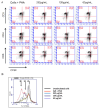Immunomodulatory effect of Tityus sp. in mononuclear cells extracted from the blood of rheumatoid arthritis patients
- PMID: 39445068
- PMCID: PMC11498904
- DOI: 10.1590/1678-9199-JVATITD-2023-0064
Immunomodulatory effect of Tityus sp. in mononuclear cells extracted from the blood of rheumatoid arthritis patients
Abstract
Background: Pathophysiological mechanisms of rheumatoid arthritis arise because of a proinflammatory environment, generated by the interaction of autoreactive lymphocytes and proinflammatory mediators. Current strategies to mitigate the progression of the disease produce adverse effects, so there is a need for new therapeutic strategies and molecular targets to treat this disease. In this context, evidence suggests that scorpion venoms could modulate the immune response and some important cellular mechanisms of pharmacological interest. To evaluate the immunomodulatory effect of the venom of Tityus sp. (a possible new species close to Tityus metuendus) peripheral blood mononuclear cells of women diagnosed with RA were compared to cells of a control group.
Methods: A case-control study was conducted with a sample of 10 women with a confirmed diagnosis of RA and controls matched by sex and age. The cytotoxicity of the venom was evaluated to find sublethal concentrations of the venom, and subsequently, their immunomodulatory capacity in terms of percentage of proliferation, cell activation, and cytokines production.
Results: the venom of Tityus sp. produced a decrease in the percentage of proliferation in the CD3+, CD3+CD4+, and CD3+CD8+ cell subpopulations of RA patients and healthy controls, at concentrations of 252 and 126 µg/mL. However, the venom did not induce significant differences in the percentage of cell activation markers. The venom caused a decrease in IL-10 at a concentration of 252 µg/mL compared to untreated cells from patients and controls. The remaining cytokines did not show significant differences.
Conclusion: the venom of Tityus sp. is a potential source of molecules with immunomodulatory ability in CD4 and CD8 T lymphocytes. This result directs venom characterization studies to identify pharmacological targets with immunomodulatory capacity in T lymphocytes to enhance research in the treatment of autoimmune disorders such as RA.
Keywords: Activation; Flow cytometry; Immunomodulatory activity; Proliferation; Rheumatoid arthritis; T lymphocytes; Tityus aff. metuendus; Tityus sp.; Venom.
Conflict of interest statement
Competing interests: The authors declare that they have no competing interests.
Figures





Similar articles
-
Immunomodulatory activity of Tityus serrulatus scorpion venom on human T lymphocytes.J Venom Anim Toxins Incl Trop Dis. 2015 Nov 11;21:46. doi: 10.1186/s40409-015-0046-3. eCollection 2015. J Venom Anim Toxins Incl Trop Dis. 2015. PMID: 26566386 Free PMC article.
-
Antimicrobial, toxicological, and antigenic characteristics of three scorpion venoms from Colombia: Centruroides margaritatus, Tityus pachyurus and Tityus n. sp. aff. metuendus.Acta Trop. 2024 Apr;252:107134. doi: 10.1016/j.actatropica.2024.107134. Epub 2024 Jan 28. Acta Trop. 2024. PMID: 38286350
-
An overview of some enzymes from buthid scorpion venoms from Colombia: Centruroides margaritatus, Tityus pachyurus, and Tityus n. sp. aff. metuendus.J Venom Anim Toxins Incl Trop Dis. 2024 Mar 18;30:e20230063. doi: 10.1590/1678-9199-JVATITD-2023-0063. eCollection 2024. J Venom Anim Toxins Incl Trop Dis. 2024. PMID: 38505508 Free PMC article.
-
Tityus serrulatus venom--A lethal cocktail.Toxicon. 2015 Dec 15;108:272-84. doi: 10.1016/j.toxicon.2015.10.015. Epub 2015 Oct 30. Toxicon. 2015. PMID: 26522893 Review.
-
Effects of Brazilian scorpion venoms on the central nervous system.J Venom Anim Toxins Incl Trop Dis. 2018 Jan 23;24:3. doi: 10.1186/s40409-018-0139-x. eCollection 2018. J Venom Anim Toxins Incl Trop Dis. 2018. PMID: 29410679 Free PMC article. Review.
Cited by
-
Influence of envenomation timing on peripheral immune and oxidative responses in experimental scorpion envenomation.J Venom Anim Toxins Incl Trop Dis. 2025 Mar 31;31:e20240059. doi: 10.1590/1678-9199-JVATITD-2024-0059. eCollection 2025. J Venom Anim Toxins Incl Trop Dis. 2025. PMID: 40170759 Free PMC article.
References
-
- McInnes IB, Schett G. Mechanism of Disease The Pathogenesis of Rheumatoid Arthritis. N Engl J Med. 2011;365(23):2205–2219. - PubMed
-
- Croia C, Bursi R, Sutera D, Petrelli F, Alunno A, Puxeddu I. One year in review 2019: pathogenesis of rheumatoid arthritis. Clin Exp Rheumatol. 2019;37(3):347–357. - PubMed
-
- Kvien TK, Uhlig T, Ødegård S, Heiberg MS. Epidemiological Aspects of Rheumatoid Arthritis: The Sex Ratio. Ann N Y Acad Sci. 2006;1069(1):212–222. - PubMed
LinkOut - more resources
Full Text Sources
Research Materials
